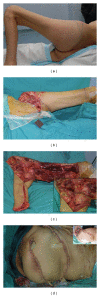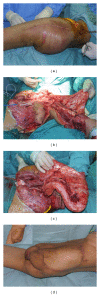Soft tissue reconstruction following hemipelvectomy: eight-year experience and literature review
- PMID: 22629187
- PMCID: PMC3353558
- DOI: 10.1100/2012/702904
Soft tissue reconstruction following hemipelvectomy: eight-year experience and literature review
Abstract
Background and objectives: Hemipelvectomy is a major surgical procedure that associates with significant morbidity, functional impairment, and psychological and body image problem. Reconstruction of the defect is a challenged since a large amount of composite tissues are needed. We would like to share our eight-year experience with massive pelvic resection and reconstruction.
Methods: A retrospective analysis of all cases of hemipelvectomy was conducted in our institution over eight-year period with particular attention given to the reconstruction choices and associated complications.
Results: Thirteen patients were included with median age of 39 years (range 13-78) of which all had advanced tumour with stage IIb (54%) and Stage III (46%). External hemipelvectomy was performed in all cases, and resultant defects were reconstructed with variety type of flaps. These include fillet thigh flaps, regional pedicle flaps of different designs, and free flap.
Conclusions: Massive pelvic tumour is rarely encountered in our population but can be seen across all age groups and usually due to late presentation. The defects should be reconstructed using local or regional flaps, incorporating the muscle component to enhance flap perfusion. The tissue should be harvested from the amputated limb, as it can limit the donor site morbidity.
Figures



References
-
- Enneking WF, Spanier SS, Goodman MA. The surgical staging of musculoskeletal sarcoma. Journal of Bone and Joint Surgery A. 1980;62(6):1027–1030. - PubMed
-
- Enneking WF, Dunham WK. Resection and reconstruction for primary neoplasms involving the innominate bone. Journal of Bone and Joint Surgery A. 1978;60(6):731–746. - PubMed
-
- Apffelstaedt JP, Driscoll DL, Spellman JE, Velez AF, Gibbs JF, Karakousis CP. Complications and outcome of external hemipelvectomy in the management of pelvic tumors. Annals of Surgical Oncology. 1996;3(3):304–309. - PubMed
-
- Hugate R, Sim FH. Pelvic reconstruction techniques. Orthopedic Clinics of North America. 2006;37(1):85–97. - PubMed
-
- Karakousis CP, Vezeridis MP. Variants of hemipelvectomy. American Journal of Surgery. 1983;145(2):273–277. - PubMed
Publication types
MeSH terms
LinkOut - more resources
Full Text Sources
Medical

